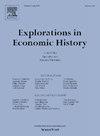Teacher shortages, the business cycle, and teacher demand: A long-run perspective
IF 1.7
1区 历史学
Q1 ECONOMICS
引用次数: 0
Abstract
This paper examines the historical relationships between teacher shortages, teacher demand, and the business cycle using Norwegian data covering a period of >160 years (1861–2024). We find a procyclical pattern in teacher shortages, in particular for the post-WW2 period. The post-WW2 results imply that doubling the unemployment rate reduces teacher shortage by about 10 percent. The finding corroborates evidence from other countries that the public sector hires employees with higher skills during recessions than during booms. In addition, teacher demand increases teacher shortages, where the finding is similar in OLS-models, IV-models, and a panel data approach for the pre-WW2 period. The results indicate that a ten percent increase in teacher demand raises teacher shortages by about 30 percent in the pre-WW2 period and about 40 percent in the post-WW2 period. The increased effects of teacher demand and the business cycles on teacher shortages over the 160-year-long period appear consistent with the centralization of school financing and teacher wage setting that took place after WW2.
教师短缺、经济周期和教师需求:一个长期视角
本文利用挪威覆盖160年(1861-2024)的数据,考察了教师短缺、教师需求和商业周期之间的历史关系。我们发现教师短缺存在顺周期模式,特别是在二战后时期。二战后的结果表明,失业率翻倍会使教师短缺减少约10%。这一发现证实了其他国家的证据,即公共部门在衰退期间雇佣的员工技能高于繁荣时期。此外,教师需求增加了教师短缺,在ols模型、iv -模型和二战前的面板数据方法中也有类似的发现。结果表明,教师需求每增加10%,二战前的教师短缺就会增加约30%,二战后的教师短缺则会增加约40%。在160年的时间里,教师需求的增加和商业周期对教师短缺的影响似乎与二战后发生的学校融资和教师工资设定的集中一致。
本文章由计算机程序翻译,如有差异,请以英文原文为准。
求助全文
约1分钟内获得全文
求助全文
来源期刊

Explorations in Economic History
Multiple-
CiteScore
2.50
自引率
8.70%
发文量
27
期刊介绍:
Explorations in Economic History provides broad coverage of the application of economic analysis to historical episodes. The journal has a tradition of innovative applications of theory and quantitative techniques, and it explores all aspects of economic change, all historical periods, all geographical locations, and all political and social systems. The journal includes papers by economists, economic historians, demographers, geographers, and sociologists. Explorations in Economic History is the only journal where you will find "Essays in Exploration." This unique department alerts economic historians to the potential in a new area of research, surveying the recent literature and then identifying the most promising issues to pursue.
 求助内容:
求助内容: 应助结果提醒方式:
应助结果提醒方式:


